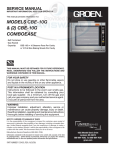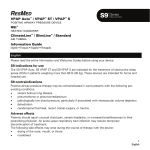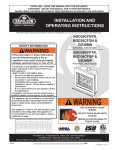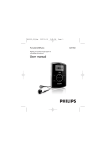Download Sony CSS-PHB Operating Instructions
Transcript
2-586-723-11 (1) Cyber-shot Station Operating Instructions GB Mode d’emploi FR CSS-PHB 2005 Sony Corporation English Before operating the product, please read this manual thoroughly and retain it for future reference. WARNING To prevent fire or shock hazard, do not expose the unit to rain or moisture. For Customers in the U.S.A. This symbol is intended to alert the user to the presence of uninsulated “dangerous voltage” within the product’s enclosure that may be of sufficient magnitude to constitute a risk of electric shock to persons. This symbol is intended to alert the user to the presence of important operating and maintenance (servicing) instructions in the literature accompanying the appliance. If you have any questions about this product, you may call: Sony Customer Information Services Center 1-800-222-SONY (7669) The number below is for the FCC related matters only. Regulatory Information Declaration of Conformity Trade Name: Model No.: Responsible Party: Address: Telephone No.: SONY CSS-PHB Sony Electronics Inc. 16450 W. Bernardo Dr, San Diego, CA 92127 U.S.A. 858-942-2230 This device complies with Part 15 of the FCC Rules. Operation is subject to the following two conditions: (1) This device may not cause harmful interference, and (2) this device must accept any interference received, including interference that may cause undesired operation. 2-GB CAUTION You are cautioned that any changes or modifications not expressly approved in this manual could void your authority to operate this equipment. Note: This equipment has been tested and found to comply with the limits for a Class B digital device, pursuant to Part 15 of the FCC Rules. These limits are designed to provide reasonable protection against harmful interference in a residential installation. This equipment generates, uses, and can radiate radio frequency energy and, if not installed and used in accordance with the instructions, may cause harmful interference to radio communications. However, there is no guarantee that interference will not occur in a particular installation. If this equipment does cause harmful interference to radio or television reception, which can be determined by turning the equipment off and on, the user is encouraged to try to correct the interference by one or more of the following measures: —Reorient or relocate the receiving antenna. —Increase the separation between the equipment and receiver. —Connect the equipment into an outlet on a circuit different from that to which the receiver is connected. —Consult the dealer or an experienced radio/TV technician for help. The supplied interface cable must be used with the equipment in order to comply with the limits for a digital device pursuant to Subpart B of Part 15 of FCC Rules. Notice on the supplied AC adaptor for customers in the United Kingdom A moulded plug complying with BS1363 is fitted to this equipment for your safety and convenience. Should the fuse in the plug supplied need to be replaced, a fuse of the same rating as the supplied or mark) must be used. one and approved by ASTA or BSI to BS1362, (i.e., marked with If the plug supplied with this equipment has a detachable fuse cover, be sure to attach the fuse cover after you change the fuse. Never use the plug without the fuse cover. If you should lose the fuse cover, please contact your nearest Sony service station. For Customers in Europe This product has been tested and found compliant with the limits sets out in the EMC Directive for using connection cables shorter than 3 meters (9.8 feet). Attention The electromagnetic field at the specific frequencies may influence the picture and sound of the camera used with this Cyber-shot Station. Notice If static electricity or electromagnetism causes data transfer to discontinue midway (fail), restart the application or disconnect and connect the communication cable (USB, etc.) again. 3-GB Features The CSS-PHB can be used with the DSC-P200 digital still camera. When you place a digital still camera (here in after referred to as the "camera") on the Cyber-shot Station, you can use the Cyber-shot Station in the following way. z You can easily view images on a TV screen by wireless remote control. Using the remote control, you can operate the followings; – Viewing images – Slide Show – Playback zoom – Shooting images z When the CSS-PHB is connected to a PictBridge enabled printer, you can easily print still images just by pressing PRINT button on the remote control. The still image currently shown on the TV can be printed by remote control. Note: If you want to print one of the still images in a Slide Show, cancel the Slide Show first, then press PRINT button. z Using the Cyber-shot Station, you can charge the battery pack inside the camera. While charging the battery pack, you can check the battery level with the CHARGE lamps of the Cyber-shot Station. z You can connect the Cyber-shot Station to your computer using the supplied USB cable for image forwarding. z You can take time-lapse photos by the built-in intervalometer of CSS-PHB. Trademarks • and Cyber-shot Station are trademarks of Sony Corporation. • “Memory Stick” and are trademarks of Sony Corporation. • In addition, system and product names used in this manual are, in general, trademarks or registered trademarks of their respective developers or manufacturers. However, the TM or ® marks are not used in all cases in this manual. 4-GB Index Precautions .......................................................................................................................... 6 Before using the Cyber-shot Station ................................................................................ 6 Identifying the parts ........................................................................................................... 7 Set up .................................................................................................................................... 8 Placing the camera on the Cyber-shot Station ............................................................... 8 Charging the battery pack ................................................................................................. 9 Viewing images on a TV screen ........................................................................................ 9 Shooting images ................................................................................................................ 10 Printing still images .......................................................................................................... 11 Connecting the camera to your computer via the Cyber-shot Station ..................... 12 Care and maintenance ..................................................................................................... 12 Troubleshooting ................................................................................................................ 13 Specifications ..................................................................................................................... 15 5-GB Precautions • The Cyber-shot Station is not a dust-proofed, moist-proofed or water proofed product. • Do not use or keep the Cyber-shot Station in locations subject to the following conditions: – Locations with extremes of temperature In closed automobiles during summer, the ambient temperature may be very hot, causing deformation or malfunction of the Cyber-shot Station. – Locations in direct sunlight or near heaters This may cause deformation or malfunction of the Cyber-shot Station. – Locations subject to vibration – Locations subject to strong magnetism – Locations subject to dust or sand If you use the Cyber-shot Station, for example, on a beach or in a desert, make sure that you keep the Cyber-shot Station away from sand. The Cyber-shot Station that is covered with sand may malfunction. • Do not use the Cyber-shot Station in locations that are subject to strong radio waves or radiation. Images may not be played back properly. • The set is not disconnected from the AC power source (mains) as long as it is connected to the wall outlet, even if the set itself has been turned off. Before using the Cyber-shot Station Refer to the operating instruction for your camera as well as this manual. • Recording contents cannot be compensated for if shooting or playback is not possible due to damaged “Memory Stick”, a malfunction of your camera or of the Cyber-shot Station, etc. • Do not connect the supplied USB cable to the multi connector on the bottom of the camera. This may cause a malfunction of the multi connector. • The screw hole on the bottom of the Cyber-shot Station is for retail display only. 6-GB Identifying the parts Cyber-shot Station Remote sensor INTERVAL SHOT button Interval selector Multi connector Interval Shot lamp CHARGE lamps A/V OUT (MONO) jack POWER lamp (USB) jack Remote sensor DC IN jack Remote Control SHUTTER button POWER button PRINT button Zoom (W/T) button Control buttons (v/V/b/B/ ) MENU button (Display / LCD on/off) button The remote control buttons share the functions as the ones on your camera. 7-GB Preparing the remote control Set up Preparing the Cyber-shot Station Connect the AC adaptor to the DC IN jack of the Cyber-shot Station. Cyber-shot Station DC plug AC adaptor To a wall outlet (wall socket) Notes on the remote control • The remote control is powered by a button type lithium battery (CR2025) installed at the factory. To avoid draining the battery, an insulation sheet is inserted. Before using the remote control for the first time, remove the insulation sheet. • Point the remote sensor of the Cyber-shot Station away from strong light sources such as direct sunlight or overhead lighting. Otherwise, the remote control may not function properly. • The remote control range is less than five meters (for indoor use). Point the remote control at the remote sensor of the Cybershot Station. Try adjusting the angle of the remote control if you cannot operate the Cyber-shot Station. Removing the insulation sheet Insulation sheet AC Power cord (mains lead) Do not use the AC adaptor placed in a narrow space, such as between a wall and furniture. Placing the camera on the Cyber-shot Station To use your Cyber-shot Station abroad - Power sources You can use the Cyber-shot Station and the AC adaptor (supplied) in any country or region where the power supply is within 100 V to 240 V AC, 50/60 Hz. Use a commercially available AC plug adaptor, if neccessary, depending on the design of the wall outlet (wall socket). AC plug adaptor Do not use an electronic transformer (travel converter), as this may cause a malfunction. 8-GB – Insert the “Memory Stick” into your camera. – Be sure to turn off the camera before placing it on the Cyber-shot Station or removing it from the Cyber-shot Station. – Be sure the camera is securely attatched to the Cyber-shot Station. Charging the battery pack Place the camera with the battery pack inserted on the Cyber-shot Station. Viewing images on a TV screen 1 Charging starts automatically. Both the / CHG lamp of the camera and the CHARGE lamps of the Cyber-shot Station light up. Connect the A/V connecting cable (supplied) to the A/V OUT (MONO) jack of the Cyber-shot Station and the audio/ video input jacks of the TV. A/V connecting cable Battery level: LOW Battery level: MIDDLE If your TV provides stereo input jacks, connect the audio plug (black) of the A/V connecting cable to the left audio jack. – Turn off both camera and TV before connecting the Cyber-shot Station and the TV by the A/V connecting cable. Battery level: HIGH • The light starts coming on from the left. • It might take a few seconds for showing an accurate battery level. • The battery level will be displayed in three levels on the CHARGE lamps of the Cybershot Station while charging the battery pack. When charging is completed, the CHARGE lamps go off. – When charging the battery pack, make sure the camera is turned off. 2 3 Set the mode dial of the camera to 4 Turn on the TV and set the TV/Video switch to “Video”. 5 Press b/B on the Control buttons of the remote control to select the desired image. . Turn on the power with the remote control. – You can also select the image by pressing b/B on the Control buttons of the camera. – The Cyber-shot Station is compatible with both NTSC and PAL TV systems. For further details, see the operating instructions supplied with the camera. 9-GB Shooting images By connecting the Cyber-shot Station to a TV, you can shoot an image while checking it on the big screen. 1 Set the mode dial of the camera to the position you desire and turn on the camera. For further details, see the operating instructions supplied with the camera. 2 Adjust the camera angle using the rotating base of the Cyber-shot Station. Taking time-lapse photos by Interval Shot 3 Set shooting interval using the interval selector of the Cyber-shot Station. You can choose the shooting interval from 5 minutes, 30 minutes or 60 minutes. 4 Press the INTERVAL SHOT button. When you press the INTERVAL SHOT button, the camera will be turned off and interval shooting (time-lapse shooting) will start. Then the Interval Shot lamp will blink green. When the camera is turned on, the Interval Shot lamp now blinks red. When the shooting is completed, the Interval Shot lamp remains red for five seconds. The camera is soon turned off to start blinking green again. 5 Shooting an image with the remote control 3 Press the SHUTTER button of the remote control. You cannot press the SHUTTER button halfway down. 10-GB Finish interval shooting. Interval shooting will finish automatically when the 12 times of shooting has completed, and then the Interval Shot lamp will go off. You can also quit interval shooting in the following ways. – Press the INTERVAL SHOT button again. – Change the interval time. – Remove the camera from the Cyber-shot Station. • When you set the camera for interval shooting, the shooting will be repeated 12 times in spite of the conditions of the camera. Make sure that the camera is ready for the shooting before you start interval shooting. For further details, see the operating instructions supplied with the camera. • During interval shooting, the camera is turned off each time an image is shot. For this reason, zoom and self-timer will return to the default settings. • You cannot use the remote control, while the interval shooting is in process. Printing still images Even if you do not have a computer, you can easily print still images by connecting your camera directly or via Cyber-shot Station to a PictBridge compliant printer. 4 Display a still image you want to print using b/B. 5 Press PRINT button. The print setting screen appears. • Refer to the operating instructions supplied with the camera for details on the printer settings, such as number of printing images, paper size and USB setting. • The available printing functions may differ depending on the printer. 1 2 Turn on the camera. 3 Connect the Cyber-shot Station to your printer by the USB cable supplied with Cyber-shot Station. – Setting items that the printer does not support cannot be displayed. 6 Select [OK] with V/B, then press The still image is printed. Set the USB mode on the camera to [PictBridge]. . Printing 2/3 Exit – When printing is completed, the screen returns to the previous screen. – Do not disconnect the USB cable while (Not disconnect USB cable) the indicator is displayed on the LCD screen. To cancel printing Select [Exit] in step 5 or 6. After the connection is made, the indicator appears on the LCD screen. When the Cyber-shot Station is communicating with your printer using the USB cable, do not remove the camera from the Cyber-shot Station. Removing the camera may damage the images. For further details, see the operating instructions supplied with the camera. 11-GB Connecting the camera to your computer via the Cyber-shot Station 1 2 Replacing the button type lithium battery * Do not use any batteries other than CR2025. 1 Pull out the battery holder while pushing the tab on the holder. 2 Take out the button type lithium battery from the holder. 3 Put a new battery into the holder with its + side facing upward. 4 Insert the holder into the remote control until it clicks. Connect the Cyber-shot Station to your computer by the USB cable supplied with the Cyber-shot Station. 4 Turn on the camera. The USB connection between the camera and your computer will be established. Then you can transfer images to your computer. For further details, see the operating instructions supplied with the camera. When the Cyber-shot Station is communicating with your computer using the USB cable, do not remove the camera from the Cyber-shot Station. Removing the camera may damage the images. Care and maintenance Clean the Cyber-shot Station with a soft cloth slightly moistened with water, and wipe the surface with a dry cloth. Do not use any type of solvent such as thinner, alcohol or benzine as this may damage the surface. WARNING Battery may explode if mistreated. Do not recharge, disassemble or dispose of in fire. CAUTION Danger of explosion if battery is incorrectly replaced. Replace only with the same or equivalent type recommended by the manufacturer. Discard used batteries according to the manufacturer's instructions. 12-GB Troubleshooting If you have trouble with your camera, try the following solutions. If the trouble persists, contact your Sony dealer. Symptom Cause/Solution Unable to charge the battery pack • The camera is turned on. t Turn the camera off. • The AC adaptor is disconnected. t Properly connect the AC adaptor. • The camera is not placed on the Cyber-shot Station correctly. t Place the camera correctly. • The battery pack is not installed correctly. t Install the battery pack correctly. • The battery pack is completely charged. Unable to turn on the camera, or it suddenly gets turned off • The camera is not placed on the Cyber-shot Station correctly. t Place the camera correctly. • The AC adaptor is disconnected. t Properly connect the AC adaptor. The images/sounds cannot be played back on a TV • The connection is not correct. t Check the connection. Your computer does not recognize your camera • The camera is turned off. t Turn on the camera. • You are not using the supplied USB cable. t Use the supplied USB cable. • The USB cable is not connected firmly. t Disconnect the USB cable from both the computer and the Cyber-shot Station, and connect it again firmly. Make sure that “USB Mode” is displayed on the LCD screen. • The camera is not placed on the Cyber-shot Station correctly. t Place the camera correctly. • The USB jacks on your computer are connected to other equipment besides the keyboard, the mouse, and the Cyber-shot Station. t Disconnect all equipment other than the keyboard, the mouse, and the Cyber-shot Station from the USB jacks. The remote control does not work • The AC adaptor is disconnected. t Connect the AC adaptor properly. • The battery in the remote control is dead. t Replace it with a new one. • The interval shooting has been turned on. t Quit the interval shooting. 13-GB Symptom Cause/Solution The connection between the printer and the Cyber-shot Station cannot be established • The printer may not be PictBridge-compliant. t Ask the printer manufacturer whether your printer is PictBridge-compliant. • The printer is not set for the connection with the camera. t Be sure that the printer is on to connect with the camera. Unable to print images • The Cyber-shot Station is not connected to the printer properly. t Check that the Cyber-shot Station and the printer are properly connected using the USB cable. • The camera is not placed on the Cyber-shot Station correctly. t Place the camera correctly. • The printer is not turned on. t Turn on the printer. For further infomation, refer to the operating instructions supplied with the printer. • Movies cannot be printed. • Still images modified with a computer or still images taken using other than the camera compatible with this Cyber-shot Station may not be able to be printed. Printing is canceled • You disconnected the USB cable before the mark disappeared. • You removed the camera from the Cyber-shot mark disappeared. Station before the The CHARGE lamps light up when no camera is placed on the Cyber-shot Station • When the camera was not placed on the Cybershot Station, you have pressed the Control buttons (in the order of v/b/V/B), then pressed the POWER button and now the Cyber-shot Station is in the demonstration mode. t To cancel the demonstration mode, discconect the AC adaptor once and connect it again. Alternatively, place the camera on the Cybershot Station. Unable to shoot an image when pressing the SHUTTER button • The AC adaptor is disconnected. t Connect the AC adaptor properly. • The camera is turned off. t Turn on the camera. • The camera is not set to the Shooting mode. t Set the Shooting mode. For further infomation, refer to the operating instructions supplied with the camera. Unable to start the interval shooting • The AC adaptor is disconnected. t Connect the AC adaptor properly. • The interval selector is not set correctly. t Set the interval selector correctly. Interval shooting is continuously working even when “Memory Stick” is full • Interval shooting automatically work up to 12 times. When the “Memory Stick” is full, still images will not be recorded. 14-GB Specifications Cyber-shot Station Input/Output connectors A/V OUT (MONO) jack (Monaural) Minijack Video*: 1 Vp-p, 75 Ω, unbalanced, sync negative Audio*: 327 mV (47 kΩ loaded) Output impedance: 2.2 kΩ * When the DSC-P200 is connected. USB jack: mini-B DC IN jack Multi connector General Dimensions (Approx.): 146 × 50 × 82 mm (5 3/4 × 2 × 3 1/4 inches) (w/h/d) Mass (Approx.): 150 g (5.3 oz) Operating temperature: 0 °C to +40 °C (32 °F to +104 °F) Storage temperature: –20 °C to +60 °C (–4 °F to +140 °F) Included items • Cyber-shot Station (CSS-PHB) (1) • Wireless Remote Commander (RMT-CSS2) (A button type lithium battery installed) (1) • A/V connecting cable (1) • USB cable (1) • AC adaptor (AC-LS5) (1) • AC Power cord (mains lead) (1) • Set of printed documentation Design and specifications are subject to change without notice. AC-LS5 AC adaptor Input rating: 100 V to 240 V AC, 50/60 Hz Output rating: 4.2 V DC* * See the label on the AC adaptor for other specifications. Dimensions (Approx.): 48 × 29 × 81 mm (1 15/16 × 1 3/16 × 3 1/4 inches) (w/h/d, excluding projecting parts) Mass (Approx.): 130 g (5 oz) excluding AC Power cord (mains lead) Operating temperature: 0 °C to +40 °C (32 °F to +104 °F) Storage temperature: –20 °C to +60 °C (–4 °F to +140 °F) 15-GB Français Avant d’utiliser cet appareil, lisez attentivement ce mode d’emploi et conservez-le pour toute référence ultérieure. AVERTISSEMENT Pour ne pas risquer un incendie ou une décharge électrique, n’exposez pas cet appareil à la pluie ou à l’humidité. Note pour les clients européens Ce produit a fait l’objet d’essais ayant permis de constater qu’il respectait les limites prescrites par la directive sur la CEM sur l’utilisation de câbles de raccordement de moins de 3 mètres (9,8 pieds). Attention Le champ électromagnétique à des fréquences particulières peut avoir une incidence sur l’image et le son de l’appareil photo utilisé avec cette Cyber-shot Station. Avis Si des interférences électriques ou électromagnétiques entraînent une interruption du transfert des données en cours (échec), relancez l’application ou débranchez et reconnectez le câble de communication (USB, etc.). 2-FR Caractéristiques Le CSS-PHB peut être utilisé avec l’appareil photo numérique DSC-P200. Si vous placez un appareil photo numérique (appelé ci-après « appareil photo ») sur la Cyber-shot Station, vous pouvez utiliser celle-ci de la manière suivante. z Vous pouvez facilement visualiser les images sur l’écran d’un téléviseur via la télécommande. La télécommande permet d’effectuer les opérations suivantes : – Visualisation d’images – Diaporama – Zoom de lecture – Prises de vues z Lorsque le CSS-PHB est raccordé à une imprimante compatible PictBridge, vous pouvez facilement imprimer des images en appuyant simplement sur la touche PRINT de la télécommande. Grâce à la télécommande, vous pouvez imprimer la photo affichée sur votre téléviseur. Remarque: Si vous souhaitez imprimer l’une des images d’un diaporama, commencez par annuler le diaporama, puis appuyez sur la touche PRINT. z La Cyber-shot Station permet de charger la batterie de l’appareil photo. Vous pouvez contrôler le niveau de la batterie en cours de charge grâce aux témoins CHARGE de la Cyber-shot Station. z Vous pouvez raccorder la Cyber-shot Station à votre ordinateur à l’aide du câble USB fourni pour le transfert des images. z Vous pouvez prendre des photos échelonnées grâce à l’intervallomètre intégré du CSS-PHB. Marques commerciales • et Cyber-shot Station sont des marques commerciales de Sony Corporation. • « Memory Stick » et sont des marques commerciales de Sony Corporation. • En outre, les noms de système et de produit utilisés dans ce manuel sont généralement des marques commerciales ou des marques déposées de leurs fabricants ou développeurs respectifs. Toutefois, les symboles TM ou ® ne sont pas toujours utilisés dans ce manuel. 3-FR Index Précautions .......................................................................................................................... 5 Avant d’utiliser la Cyber-shot Station ............................................................................. 5 Identification des différents éléments .............................................................................. 6 Installation ........................................................................................................................... 7 Placement de l’appareil photo sur la Cyber-shot Station ............................................. 7 Recharge de la batterie ....................................................................................................... 8 Visualisation d’images sur un écran de téléviseur ........................................................ 8 Prises de vues ...................................................................................................................... 9 Impression d’images fixes ............................................................................................... 10 Raccordement de l’appareil photo à votre ordinateur via la Cyber-shot Station ..... 11 Nettoyage et entretien ....................................................................................................... 11 Dépannage ......................................................................................................................... 12 Spécifications ..................................................................................................................... 15 4-FR Précautions • La Cyber-shot Station ne doit pas être soumise à la poussière, à l’humidité et à l’eau. • N’utilisez pas et ne rangez pas la Cyber-shot Station dans les endroits suivants : – Endroits soumis à des températures extrêmes La température à l’intérieur d’une voiture fermée pendant l’été peut être très élevée et risque de déformer la Cyber-shot Station ou d’entraîner un problème de fonctionnement. – Endroits soumis à la lumière directe du soleil ou près de radiateurs Cela risque de déformer la Cyber-shot Station ou d’entraîner un problème de fonctionnement. – Endroits soumis à des vibrations – Endroits soumis à des champs magnétiques puissants – Endroits poussiéreux ou sablonneux Si, par exemple, vous utilisez la Cyber-shot Station sur une plage ou dans le désert, protégezla du sable. Si elle est couverte de sable, la Cyber-shot Station risque de fonctionner de manière incorrecte. • N’utilisez pas la Cyber-shot Station dans des endroits soumis à des ondes radio ou à des rayonnements puissants. Les images risquent de ne pas pouvoir être lues correctement. • L’appareil n’est pas déconnecté de la source d’alimentation secteur tant qu’il reste branché sur la prise murale, même s’il a été mis hors tension. Avant d’utiliser la Cyber-shot Station Consultez le mode d’emploi de votre appareil ainsi que ce manuel. • Aucune compensation relative au contenu de l’enregistrement ne sera accordée si la prise de vues ou la lecture ne se font pas en raison d’un « Memory Stick » endommagé, d’un mauvais fonctionnement de votre appareil photo ou de la Cyber-shot Station, etc. • Ne raccordez pas le câble USB fourni au multi-connecteur au bas de l’appareil photo. Cela risque d’entraîner un problème de fonctionnement du multi-connecteur. • Le trou de vis situé au bas de la Cyber-shot Station est réservé à sa présentation en magasin. 5-FR Identification des différents éléments Cyber-shot Station Capteur à distance Touche INTERVAL SHOT Sélecteur d’intervalles Témoin Interval Shot Témoins CHARGE Multiconnecteur Prise A/V OUT (MONO) Prise Témoin POWER (USB) Capteur à distance Prise DC IN Télécommande Touche SHUTTER Touche POWER Touche PRINT Touche de Zoom (W/T) Touches de commande (v/V/b/B/ ) Touche MENU Touche (activation/désactivation de l’affichage / écran LCD) Les fonctions des touches de la télécommande sont les mêmes que celles de votre appareil photo. 6-FR Installation Préparation de la Cyber-shot Station Raccordez l’adaptateur secteur à la prise DC IN de la Cyber-shot Station. Cyber-shot Station • Eloignez le capteur à distance de la Cybershot Station des sources de lumière fortes telles que la lumière directe du soleil ou un plafonnier. Sinon, la télécommande risque de ne pas fonctionner correctement. • La télécommande fonctionne dans un rayon inférieur à cinq mètres (lorsqu’elle est utilisée à l’intérieur). Dirigez la télécommande vers le capteur à distance de la Cyber-shot Station. Si la Cyber-shot Station ne répond pas, ajustez l’angle de la télécommande. Retrait de la feuille isolante Fiche DC Adaptateur secteur Vers une prise murale Cordon d’alimentation secteur Feuille isolante Placement de l’appareil photo sur la Cyber-shot Station Ne placez pas l’adaptateur secteur dans un endroit exigu, par exemple entre un mur et un meuble. Pour utiliser votre Cyber-shot Station à l’étranger - Sources d’alimentation Vous pouvez utiliser la Cyber-shot Station et l’adaptateur secteur (fourni) dans n’importe quel pays ou région où la tension d’alimentation est comprise entre 100 V et 240 V CA, 50/60 Hz. N’utilisez pas de transformateur électronique (convertisseur de voyage), car cela risquerait d’entraîner un problème de fonctionnement. Actions préalables en vue de l’utilisation de la télécommande Remarques sur la télécommande • La télécommande est alimentée par une pile bouton (CR2025) mise en place en usine. Une feuille isolante est insérée pour protéger la pile. Avant d’utiliser la télécommande pour la première fois, retirez la feuille isolante. – Insérez le « Memory Stick » dans votre appareil photo. – Assurez-vous que l’appareil photo est hors tension avant de le placer sur la Cyber-shot Station ou de l’en retirer. – Vérifiez que l’appareil photo est correctement fixé à la Cyber-shot Station. 7-FR Recharge de la batterie Insérez la batterie dans l’appareil photo, puis placez-le sur la Cyber-shot Station. La charge commence automatiquement. Le témoin /CHG de l’appareil photo et les témoins CHARGE de la Cyber-shot Station s’allument. Visualisation d’images sur un écran de téléviseur 1 Raccordez le câble de liaison audio et vidéo (fourni) à la prise A/V OUT (MONO) de la Cyber-shot Station et aux prises d’entrée audio/vidéo du téléviseur. Câble de liaison audio/vidéo Niveau de la batterie : FAIBLE Niveau de la batterie : MOYEN Si votre téléviseur est équipé de prises d’entrée stéréo, raccordez la fiche audio (noire) du câble de liaison audio/vidéo à la prise audio située à gauche. Niveau de la batterie : HAUT • Le témoin de gauche s’allume en premier. • L’affichage du niveau de batterie adéquat peut prendre quelques secondes. • Le niveau de la batterie est indiqué par les trois segments des témoins CHARGE de la Cyber-shot Station pendant la charge de la batterie. Lorsque la batterie est entièrement rechargée, les témoins CHARGE s’éteignent. – Assurez-vous que l’appareil photo est hors tension pendant la charge de la batterie. 8-FR – Mettez l’appareil photo et le téléviseur hors tension avant de raccorder la Cyber-shot Station et le téléviseur à l’aide du câble de liaison audio/vidéo. 2 Réglez le sélecteur de mode de l’appareil . photo sur 3 Mettez l’appareil sous tension à l’aide de la télécommande. 4 Mettez le téléviseur sous tension et réglez le commutateur TV/Vidéo sur « Vidéo ». 5 Appuyez sur les touches de commande b/B de la télécommande pour sélectionner l’image de votre choix. – Vous pouvez aussi sélectionner l’image en appuyant sur les touches de commande b/B de l’appareil photo. – La Cyber-shot Station est compatible avec les systèmes de télévision NTSC et PAL. Pour plus d’informations, reportezvous au mode d’emploi fourni avec l’appareil photo. Prises de vues Prise de vues échelonnées grâce au mode de prise de vues à intervalle 3 Spécifiez l’intervalle de prise de vues à l’aide du sélecteur d’intervalles de la Cyber-shot Station. Vous avez le choix entre les intervalles de prise de vues suivants : 5, 30 et 60 minutes. 4 Appuyez sur la touche INTERVAL SHOT. Lorsque vous appuyez sur la touche INTERVAL SHOT, l’appareil photo est mis hors tension et la prise de vues à intervalle (échelonnée) démarre. Ensuite, le témoin Interval Shot clignote en vert. En raccordant la Cyber-shot Station à un téléviseur, vous contrôler sur grand écran la photo que vous prenez. 1 2 Réglez le sélecteur de mode de l’appareil photo sur la position souhaitée, puis mettez l’appareil photo sous tension. Pour plus d’informations, reportez-vous au mode d’emploi fourni avec l’appareil photo. Dès que l’appareil photo est mis sous tension, le témoin Interval Shot clignote en rouge. Une fois la photo prise, le témoin Interval Shot reste rouge pendant cinq secondes. Bientôt, l’appareil photo est mis hors tension et le témoin recommence à clignoter en vert. Ajustez l’angle de l’appareil photo à l’aide de la base pivotante de la Cybershot Station. 5 Prise de vues à l’aide de la télécommande 3 Appuyez sur la touche SHUTTER de la télécommande. Vous ne pouvez pas enfoncer la touche SHUTTER à mi-course. Mettez fin à la prise de vues à intervalle. L’appareil met automatiquement fin à la prise de vues à intervalle dès que le cycle de 12 prises de vues est terminé. Le témoin Interval Shot s’éteint. Vous pouvez également quitter le mode de prise de vues à intervalle en procédant d’une des manières suivantes. – En appuyant de nouveau sur la touche INTERVAL SHOT. – En changeant la durée d’intervalle. – En ôtant l’appareil photo de la Cybershot Station. • Lorsque vous réglez l’appareil photo sur le mode de prise de vues à intervalle, 12 prises de vues s’exécutent de manière ininterrompue quelles que soient les circonstances. Assurez-vous que l’appareil photo est prêt à photographier avant de démarrer la prise de vues à intervalle. Pour plus d’informations, reportez-vous au mode d’emploi fourni avec l’appareil photo. 9-FR • Pendant la prise de vues à intervalle, l’appareil photo est mis hors tension à chaque prise de vues. Le zoom et le retardateur reviennent donc à leurs valeurs par défaut. • Vous ne pouvez pas utiliser la télécommande pendant la prise de vues à intervalle. Impression d’images fixes Même si vous ne disposez pas d’un ordinateur, vous pouvez aisément imprimer des images fixes en raccordant votre appareil photo à une imprimante compatible PictBridge soit directement, soit via une Cyber-shot Station. • Reportez-vous au mode d’emploi fourni avec l’appareil photo pour obtenir des informations détaillées sur les réglages de l’imprimante tels que le nombre d’impressions, le format de papier et la configuration USB. • Les fonctions d’impression disponibles peuvent varier en fonction de l’imprimante. 1 2 Mettez l’appareil photo sous tension. 3 Raccordez la Cyber-shot Station à votre imprimante à l’aide du câble USB fourni avec la Cyber-shot Station. Réglez le mode USB de l’appareil photo sur [PictBridge]. Une fois la connexion établie, l’indicateur apparaît sur l’écran LCD. Ne retirez pas l’appareil photo de la Cybershot Station pendant que celle-ci communique avec votre imprimante via le câble USB, car cela risquerait d’altérer les photos. Pour plus d’informations, reportez-vous au mode d’emploi fourni avec l’appareil photo. 4 Affichez l’image fixe que vous voulez imprimer à l’aide des touches b/B. 5 Appuyez sur la touche PRINT. L’écran de réglage de l’impression apparaît. 1M 101 2/9 Imprim Index Désact Taille Img Par défaut Date Désact Quantité 1 Sortie OK – Il est impossible d’afficher des éléments de réglage non pris en charge par l’imprimante. 6 Sélectionnez [OK] à l’aide de V/B, puis appuyez sur . L’image fixe est imprimée. Impression en cours 2/3 Sortie – Lorsque l’impression est terminée, l’écran précédent apparaît. – Ne débranchez pas le câble USB lorsque le témoin (ne pas déconnecter le câble USB) apparaît sur l’écran LCD. Pour annuler l’impression Sélectionnez [Sortie] à l’étape 5 ou 6. 10-FR Raccordement de l’appareil photo à votre ordinateur via la Cyber-shot Station 1 Raccordez la Cyber-shot Station à votre ordinateur à l’aide du câble USB fourni avec la Cyber-shot Station. ATTENTION Danger d’explosion en cas de remplacement incorrect de la batterie. Remplacez la batterie uniquement par une batterie de type identique ou similaire recommandé par le fabricant. Mettez les batteries usées au rebut conformément aux instructions du fabricant. Remplacement de la pile bouton au lithium * N’utilisez pas de piles autres que celles de type CR2025. 1 Retirez le support de la pile tout en appuyant sur sa languette. 2 Retirez la pile bouton au lithium de son support. 3 Placez une pile neuve dans le support, pôle + vers le haut. 4 Insérez le support dans la télécommande jusqu’à ce qu’il s’encliquette. 4 2 Mettez l’appareil photo sous tension. La connexion USB est établie entre l’appareil photo et votre ordinateur. Vous pouvez alors transférer les photos vers votre ordinateur. Pour plus d’informations, reportez-vous au mode d’emploi fourni avec l’appareil photo. Ne retirez pas l’appareil photo de la Cybershot Station pendant que celle-ci communique avec votre ordinateur via le câble USB, car cela risquerait d’altérer les photos. Nettoyage et entretien Nettoyez la Cyber-shot Station avec un chiffon doux légèrement humidifié, puis essuyez sa surface avec un chiffon sec. N’utilisez pas de solvants, tels que du diluant, de l’alcool ou de l’essence, qui risqueraient d’abîmer la surface de l’appareil. AVERTISSEMENT La pile peut exploser si vous ne la manipulez pas avec soin. Ne rechargez pas la pile, ne la démontez et ne la jetez pas au feu. 11-FR Dépannage Si vous rencontrez des problèmes avec votre appareil photo, essayez les solutions suivantes. Si les problèmes persistent, contactez votre revendeur Sony. Symptôme Cause/Solution Impossible de charger la batterie • L’appareil photo est sous tension. t Mettez-le hors tension. • L’adaptateur secteur est débranché. t Raccordez correctement l’adaptateur secteur. • L’appareil photo n’est pas placé correctement sur la Cyber-shot Station. t Placez correctement l’appareil photo. • La batterie n’est pas installée correctement. t Installez la batterie correctement. • La batterie est complètement chargée. Impossible de mettre sous tension l’appareil photo, car il s’éteint de luimême de manière inattendue • L’appareil photo n’est pas placé correctement sur la Cyber-shot Station. t Placez correctement l’appareil photo. • L’adaptateur secteur est débranché. t Raccordez correctement l’adaptateur secteur. Impossible de lire les images/sons sur un téléviseur • La connexion n’est pas correcte. t Vérifiez la connexion. L’ordinateur ne reconnaît pas votre appareil photo • L’appareil photo est hors tension. t Mettez l’appareil photo sous tension. • Vous n’utilisez pas le câble USB fourni. t Utilisez le câble USB fourni. • Le câble USB n’est pas raccordé correctement. t Débranchez le câble USB de l’ordinateur et de la Cyber-shot Station et raccordez-le de nouveau fermement. Vérifiez que l’indication « Mode USB » est affichée sur l’écran LCD. • L’appareil photo n’est pas placé correctement sur la Cyber-shot Station. t Placez correctement l’appareil photo. • Les prises USB de votre ordinateur sont raccordées à un autre appareil, en plus du clavier, de la souris et de la Cyber-shot Station. t Débranchez tous les appareils autres que le clavier, la souris et la Cyber-shot Station des prises USB. La télécommande ne fonctionne pas • L’adaptateur secteur est débranché. t Raccordez correctement l’adaptateur secteur. • La pile de la télécommande est épuisée. t Remplacez-la par une pile neuve. • La prise de vues à intervalle a été activée. t Quittez la prise de vues à intervalle. 12-FR Symptôme Cause/Solution Impossible d’établir la connexion entre l’imprimante et la Cyber-shot Station • L’imprimante n’est pas compatible PictBridge. t Demandez au fabricant de l’imprimante si elle est compatible PictBridge. • N’imprimante n’est pas réglée pour être raccordée à l’appareil photo. t Vérifiez si l’imprimante est sous tension et si elle peut être raccordée à l’appareil photo. Impossible d’imprimer des photos • La Cyber-shot Station n’est pas correctement raccordée à l’imprimante. t Vérifiez que la Cyber-shot Station et l’imprimante sont raccordées correctement à l’aide du câble USB. • L’appareil photo n’est pas placé correctement sur la Cyber-shot Station. t Placez correctement l’appareil photo. • L’imprimante n’est pas sous tension. t Mettez l’imprimante sous tension. Pour plus d’informations, reportez-vous au mode d’emploi fourni avec l’imprimante. • Il est impossible d’imprimer des films. • Il est possible que des photos modifiées à l’aide d’un ordinateur ou prises à l’aide d’un appareil photo autre que le présent appareil compatible avec la Cyber-shot Station ne puissent pas être imprimées. L’impression est annulée • Vous avez débranché le câble USB avant la . disparition du témoin • Vous avez retiré l’appareil photo de la Cyber-shot . Station avant la disparition du témoin Les témoins CHARGE s’allument alors qu’aucun appareil photo n’est placé sur la Cyber-shot Station • Alors que l’appareil photo n’était pas placé sur la Cyber-shot Station, vous avez appuyé sur les touches de commande (dans l’ordre v/b/V/B), puis sur la touche POWER. A présent, la Cybershot Station est en mode de démonstration. t Pour annuler le mode de démonstration, débranchez l’adaptateur secteur, puis rebranchez-le. Vous pouvez également placer l’appareil photo sur la Cyber-shot Station. Impossible de prendre une photo en appuyant sur la touche SHUTTER • L’adaptateur secteur est débranché. t Raccordez correctement l’adaptateur secteur. • L’appareil photo est hors tension. t Mettez l’appareil photo sous tension. • L’appareil photo n’est pas en mode de prise de vues. t Faites-le passer en mode de prise de vues. Pour plus d’informations, reportez-vous au mode d’emploi fourni avec l’appareil photo. 13-FR Symptôme Cause/Solution Impossible de démarrer la prise de vues à intervalle • L’adaptateur secteur est débranché. t Raccordez correctement l’adaptateur secteur. • Le sélecteur d’intervalle n’est pas réglé correctement. t Réglez correctement le sélecteur d’intervalles. La prise de vues à intervalle se poursuit même lorsque le « Memory Stick » est saturé • La prise de vues à intervalle permet de prendre jusqu’à 12 vues consécutives. Les photos ne seront pas enregistrées si le « Memory Stick » est saturé. 14-FR Spécifications Cyber-shot Station Connecteurs d’entrée/de sortie Prise A/V OUT (MONO) (monaural) Miniprise Vidéo*: 1 Vp-p, 75 Ω, asymétrique, sync négative Audio*: 327 mV (à une charge de 47 kΩ) Impédance de sortie : 2,2 kΩ * Lorsque le DSC-P200 est raccordé. Prise USB : mini-B Prise DC IN Multi-connecteur Caractéristiques générales Dimensions (environ) : 146 × 50 × 82 mm (5 3/4 × 2 × 3 1/4 pouces) (l/h/p) Poids (environ) : 150 g (5,3 onces) Température de fonctionnement : 0 °C à +40 °C (32 °F à +104 °F) Température de stockage : –20 °C à +60 °C (–4 °F à +140 °F) Articles inclus • Cyber-shot Station (CSS-PHB) (1) • Télécommande sans fil (RMT-CSS2) (Pile bouton au lithium déjà installée) (1) • Câble de liaison audio/vidéo (1) • Câble USB (1) • Adaptateur secteur (AC-LS5) (1) • Cordon d’alimentation secteur (1) • Jeu de documents imprimés La conception et les spécifications sont sujettes à modification sans préavis. Adaptateur secteur AC-LS5 Tension d’alimentation : 100 V à 240 V CA, 50/60 Hz Tension de sortie : 4,2 V CC* * Reportez-vous à l’étiquette collée sur l’adaptateur secteur pour connaître les autres spécifications. Dimensions (environ) : 48 × 29 × 81 mm (1 15/16 × 1 3/16 × 3 1/4 pouces) (l/h/p, à l’exclusion des parties saillantes) Poids (environ) : 130 g (5 onces) à l’exclusion du cordon d’alimentation CA Température de fonctionnement : 0 °C à +40 °C (32 °F à +104 °F) Température de stockage : –20 °C à +60 °C (–4 °F à +140 °F) 15-FR Printed on 100% recycled paper using VOC (Volatile Organic Compound)-free vegetable oil based ink. Imprimé sur papier 100 % recyclé avec de I’encre á base d’huile végétale sans COV (composés organiques volatils). Printed in Japan
This document in other languages
- français: Sony CSS-PHB
































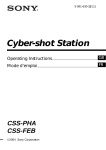
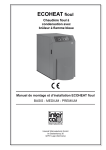
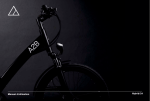
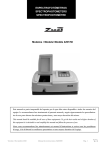

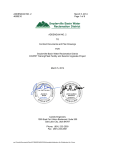
![Foyer Napoléon GD-36 manuel Fr [3,11 Mo]](http://vs1.manualzilla.com/store/data/006313775_2-728e225ad06644f8febf76921e05f7d5-150x150.png)
